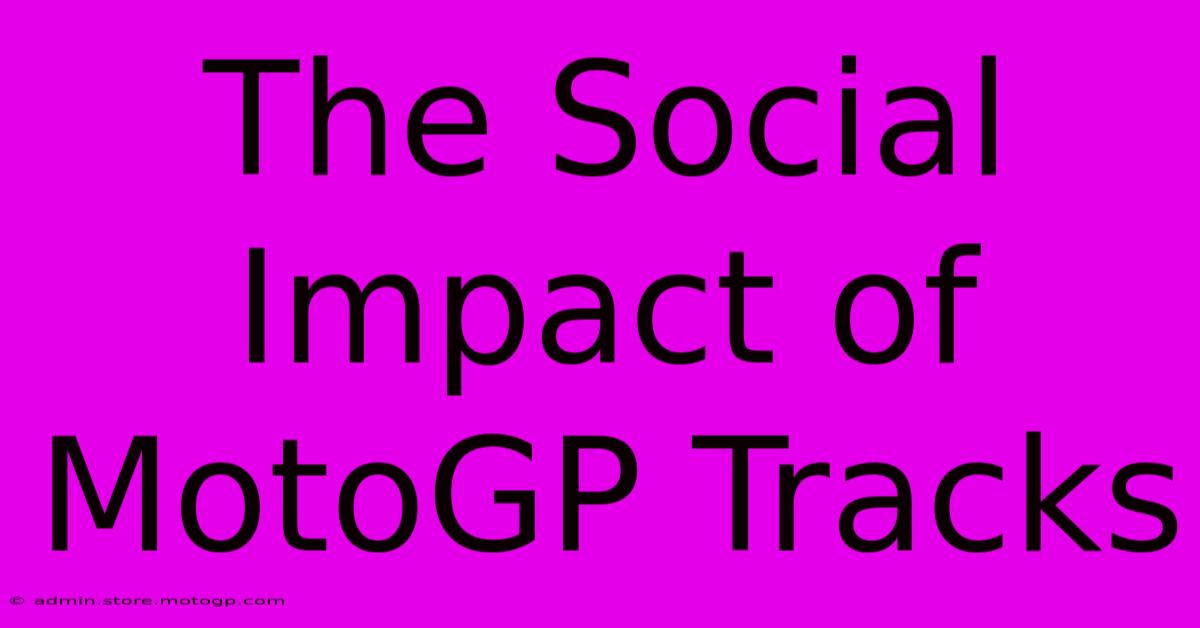The Social Impact Of MotoGP Tracks

Table of Contents
The Social Impact of MotoGP Tracks: More Than Just a Race
MotoGP, the pinnacle of motorcycle racing, boasts a global following and generates significant economic and social impacts beyond the roar of the engines. While the thrill of the race is undeniable, the construction and operation of MotoGP tracks have far-reaching consequences on the communities that host them. This article explores the multifaceted social impact of these iconic venues, examining both the positive and negative aspects.
Economic Benefits: A Boon to Local Economies
The economic benefits of hosting a MotoGP race are substantial and often touted as a primary reason for attracting the sport. These benefits include:
-
Tourism Surge: MotoGP races attract thousands of spectators, boosting local businesses like hotels, restaurants, and transportation services. The influx of tourists generates significant revenue and creates temporary employment opportunities. This is especially beneficial for regions relying on seasonal tourism.
-
Infrastructure Development: The construction and improvement of racetracks often lead to upgrades in local infrastructure, including roads, transportation networks, and communication systems. These improvements benefit the community long after the race concludes.
-
Investment and Job Creation: The construction and ongoing operation of the track itself create permanent jobs, contributing to local employment and reducing unemployment rates. This long-term impact is a key factor in the positive social impact.
Beyond the Immediate Economic Gains
While the immediate economic benefits are considerable, it's crucial to consider the long-term economic sustainability. A well-planned strategy ensures that the economic boost is not short-lived but leads to sustained growth and diversification of the local economy. This might involve training programs for locals to work in the tourism sector or investment in other related industries.
Social Impacts: A Double-Edged Sword
While the economic benefits are undeniable, the social impacts of MotoGP tracks are more nuanced and require careful consideration.
Positive Social Impacts:
-
Community Pride and Identity: Hosting a major international event like a MotoGP race can foster a sense of community pride and strengthen local identity. The event becomes a source of collective excitement and shared experience.
-
Global Exposure: The international media attention surrounding a MotoGP race can significantly increase a region's global visibility, attracting further investment and tourism in the future. This positive publicity can have a lasting impact.
-
Social Cohesion: The event can bring together diverse communities, creating opportunities for interaction and social cohesion. This is particularly relevant in areas with diverse populations.
Negative Social Impacts:
-
Displacement and Gentrification: The construction of a MotoGP track and associated infrastructure can lead to displacement of local residents and businesses, particularly if land acquisition is not handled fairly and transparently. Gentrification can also result, raising the cost of living and pushing out long-term residents.
-
Environmental Concerns: The construction and operation of a racetrack can have significant environmental impacts, including noise pollution, air pollution, and habitat destruction. Effective environmental mitigation strategies are crucial to minimize these negative effects.
-
Strain on Infrastructure: The influx of tourists can strain existing infrastructure, leading to traffic congestion, overcrowding, and increased demand on public services. Adequate planning and infrastructure upgrades are vital to manage these challenges.
Sustainability and Responsible Development: A Path Forward
To maximize the positive social impact and minimize the negative consequences, a responsible and sustainable approach is essential. This includes:
-
Community Engagement: Meaningful consultation with local communities is crucial throughout the planning and construction phases. This ensures their concerns are addressed and their participation is valued.
-
Environmental Protection: Implementing stringent environmental impact assessments and mitigation strategies is essential to minimize the environmental footprint of the racetrack and the event.
-
Long-Term Economic Planning: Developing strategies to ensure the economic benefits extend beyond the race itself, creating sustainable employment opportunities and diversification of the local economy.
Conclusion:
The social impact of MotoGP tracks is multifaceted, encompassing both substantial economic benefits and potential social and environmental challenges. By adopting a responsible and sustainable approach that prioritizes community engagement, environmental protection, and long-term economic planning, the positive impacts of these iconic venues can be maximized, leaving a lasting legacy for the communities that host them. The future of MotoGP's social impact hinges on a proactive and ethical commitment to sustainable development.

Thank you for visiting our website wich cover about The Social Impact Of MotoGP Tracks. We hope the information provided has been useful to you. Feel free to contact us if you have any questions or need further assistance. See you next time and dont miss to bookmark.
Featured Posts
-
Get Your Adrenaline Fix Sprint Race Austin
Feb 19, 2025
-
Sting F1 Where Innovation Meets Performance
Feb 19, 2025
-
The Ultimate Guide To Moto Gp Points
Feb 19, 2025
-
Unleash Your Inner Racer Tnt Sports Moto Gp Schedule
Feb 19, 2025
-
F1 Austin 2025 Experience The Power
Feb 19, 2025
